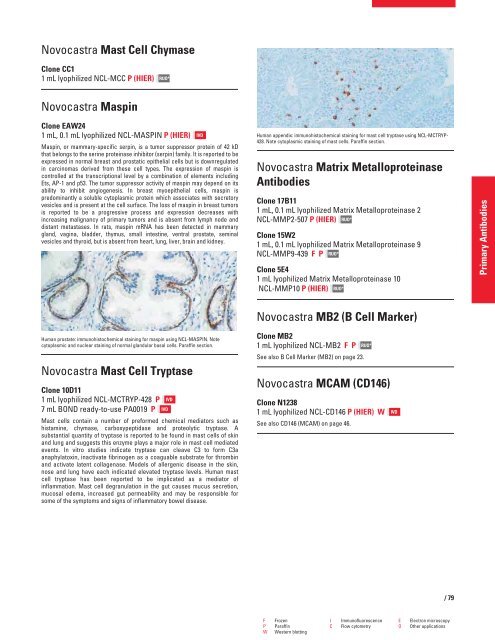QF0159 Marketing Release Record
QF0159 Marketing Release Record
QF0159 Marketing Release Record
Create successful ePaper yourself
Turn your PDF publications into a flip-book with our unique Google optimized e-Paper software.
Novocastra Mast Cell Chymase<br />
Clone CC1<br />
1 mL lyophilized NCL-MCC P (HIER)<br />
Novocastra Maspin<br />
Clone EAW24<br />
1 mL, 0.1 mL lyophilized NCL-MASPIN P (HIER)<br />
Maspin, or mammary-specific serpin, is a tumor suppressor protein of 42 kD<br />
that belongs to the serine proteinase inhibitor (serpin) family. It is reported to be<br />
expressed in normal breast and prostatic epithelial cells but is downregulated<br />
in carcinomas derived from these cell types. The expression of maspin is<br />
controlled at the transcriptional level by a combination of elements including<br />
Ets, AP-1 and p53. The tumor suppressor activity of maspin may depend on its<br />
ability to inhibit angiogenesis. In breast myoepithelial cells, maspin is<br />
predominantly a soluble cytoplasmic protein which associates with secretory<br />
vesicles and is present at the cell surface. The loss of maspin in breast tumors<br />
is reported to be a progressive process and expression decreases with<br />
increasing malignancy of primary tumors and is absent from lymph node and<br />
distant metastases. In rats, maspin mRNA has been detected in mammary<br />
gland, vagina, bladder, thymus, small intestine, ventral prostate, seminal<br />
vesicles and thyroid, but is absent from heart, lung, liver, brain and kidney.<br />
Human prostate: immunohistochemical staining for maspin using NCL-MASPIN. Note<br />
cytoplasmic and nuclear staining of normal glandular basal cells. Paraffin section.<br />
Novocastra Mast Cell Tryptase<br />
Clone 10D11<br />
1 mL lyophilized NCL-MCTRYP-428 P<br />
7 mL BOND ready-to-use PA0019 P<br />
RUO*<br />
Mast cells contain a number of preformed chemical mediators such as<br />
histamine, chymase, carboxypeptidase and proteolytic tryptase. A<br />
substantial quantity of tryptase is reported to be found in mast cells of skin<br />
and lung and suggests this enzyme plays a major role in mast cell mediated<br />
events. In vitro studies indicate tryptase can cleave C3 to form C3a<br />
anaphylatoxin, inactivate fibrinogen as a coaguable substrate for thrombin<br />
and activate latent collagenase. Models of allergenic disease in the skin,<br />
nose and lung have each indicated elevated tryptase levels. Human mast<br />
cell tryptase has been reported to be implicated as a mediator of<br />
inflammation. Mast cell degranulation in the gut causes mucus secretion,<br />
mucosal edema, increased gut permeability and may be responsible for<br />
some of the symptoms and signs of inflammatory bowel disease.<br />
IVD<br />
IVD<br />
IVD<br />
Human appendix: immunohistochemical staining for mast cell tryptase using NCL-MCTRYP-<br />
428. Note cytoplasmic staining of mast cells. Paraffin section.<br />
Novocastra Matrix Metalloproteinase<br />
Antibodies<br />
Clone 17B11<br />
1 mL, 0.1 mL lyophilized Matrix Metalloproteinase 2<br />
NCL-MMP2-507 P (HIER) RUO*<br />
Clone 15W2<br />
1 mL, 0.1 mL lyophilized Matrix Metalloproteinase 9<br />
NCL-MMP9-439 FP RUO*<br />
Clone 5E4<br />
1 mL lyophilized Matrix Metalloproteinase 10<br />
NCL-MMP10 P (HIER) RUO*<br />
Novocastra MB2 (B Cell Marker)<br />
Clone MB2<br />
1 mL lyophilized NCL-MB2 FP<br />
See also B Cell Marker (MB2) on page 23.<br />
Novocastra MCAM (CD146)<br />
Clone N1238<br />
1 mL lyophilized NCL-CD146 P (HIER) W<br />
See also CD146 (MCAM) on page 46.<br />
RUO*<br />
IVD<br />
F Frozen I Immunofluorescence E Electron microscopy<br />
P Paraffin C Flow cytometry O Other applications<br />
W Western blotting<br />
/79<br />
Primary Antibodies
















